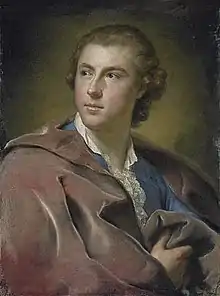William Burton Conyngham
William Burton Conyngham (1733 – 31 May 1796) was an Irish politician and improver.
William Burton Conyngham | |
|---|---|
 portrait by Anton Raphael Mengs (1754/1755) | |
| Member of the Parliament of Ireland | |
| In office 1761–1796 | |
| Personal details | |
| Born | 1733 |
| Died | 31 May 1796 |
| Parent |
|
Life
He was born William Burton, the second son of Francis Burton and Mary Conyngham, sister of Henry Conyngham, 1st Earl Conyngham.[1] In 1781, his name was changed by Royal Licence to inherit the estates of his uncle.
Conyngham was a longtime Member of Parliament. From 1761 to 1777 he represented Newtown Limavady,[1] from 1776 to 1777 as well as from 1783 to 1790 Killybegs. Between 1776 and 1783 and again between 1790 and 1796, he sat in the Irish House of Commons for Ennis.

Conyngham planned a settlement on the previously unpopulated island of Rutland, Ireland, having installed, from 1784, a street of residences and business premises, post office, school house and a fish landing and processing facility. The island remained inhabited into the 1960s. The village which developed around the mainland pier which served Rutland, Burtonport, still bears his name.[2]
.jpg.webp)
In 1785 Conyngham commenced the building of Slane Castle, assisted by his nephew the 1st Marquess Conyngham, on a site overlooking the River Boyne just a few kilometres upstream from the site of the Battle of the Boyne.
From 1793 Conyngham was one of the Commissioners of the Treasury for Ireland.
Conyngham is most famous today for having presented the Trinity College Harp to Trinity College Dublin; from 1922 the harp was used as the model for the insignia of the Irish Free State and the Republic of Ireland. An image was also registered as a Guinness trade mark in 1876.[3]
References
- Kelly, James. "Conyngham, William Burton". Oxford Dictionary of National Biography (online ed.). Oxford University Press. doi:10.1093/ref:odnb/67005. (Subscription or UK public library membership required.)
- "Burtonport".
- Dennison, S.R. (Stanley Raymond); Oliver McDonagh (1998). Guinness 1886-1939: From Incorporation to the Second World War. Cork University Press. p. 9. ISBN 9781859181751.